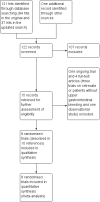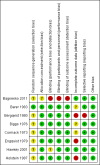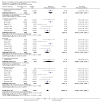Tranexamic acid for upper gastrointestinal bleeding
- PMID: 25414987
- PMCID: PMC6599825
- DOI: 10.1002/14651858.CD006640.pub3
Tranexamic acid for upper gastrointestinal bleeding
Abstract
Background Tranexamic acid reduces haemorrhage through its antifibrinolytic effects. In a previous version of the present review, we found that tranexamic acid may reduce mortality. This review includes updated searches and new trials.Objectives To assess the effects of tranexamic acid versus no intervention, placebo or other antiulcer drugs for upper gastrointestinal bleeding.Search methods We updated the review by performing electronic database searches (Cochrane Central Register of Controlled Trials (CENTRAL),MEDLINE, EMBASE, Science Citation Index) and manual searches in July 2014.Selection criteriaRandomised controlled trials, irrespective of language or publication status.Data collection and analysis We used the standard methodological procedures of the The Cochrane Collaboration. All-cause mortality, bleeding and adverse events were the primary outcome measures. We performed fixed-effect and random-effects model meta-analyses and presented results as risk ratios (RRs) with 95% confidence intervals (CIs) and used I² as a measure of between-trial heterogeneity. We analysed tranexamic acid versus placebo or no intervention and tranexamic acid versus antiulcer drugs separately. To analyse sources of heterogeneity and robustness of the overall results, we performed subgroup, sensitivity and sequential analyses.Main results We included eight randomised controlled trials on tranexamic acid for upper gastrointestinal bleeding. Additionally, we identified one large ongoing pragmatic randomised controlled trial from which data are not yet available. Control groups were randomly assigned to placebo (seven trials) or no intervention (one trial). Two trials also included a control group randomly assigned to antiulcer drugs(lansoprazole or cimetidine). The included studies were published from 1973 to 2011. The number of participants randomly assigned ranged from 47 to 216 (median 204). All trials reported mortality. In total, 42 of 851 participants randomly assigned to tranexamic acid and 71 of 850 in the control group died (RR 0.60, 95% CI 0.42 to 0.87; P value 0.007; I² = 0%). The analysis was not confirmed when all participants in the intervention group with missing outcome data were included as treatment failures, or when the analysis was limited to trials with low risk of attrition bias. Rebleeding was diagnosed for 117 of 826 participants in the tranexamic acid group and for 146 of 825 participants in the control group (RR 0.80, 95% CI 0.64 to 1.00; P value 0.07; I² = 49%).We were able to evaluate the risk of serious adverse events on the basis of only four trials. Our analyses showed 'no evidence of a difference between tranexamic acid and control interventions regarding the risk of thromboembolic events.’ Tranexamic acid appeared to reduce the risk of surgery ina fixed-effect meta-analysis (RR 0.73, 95% CI 0.56 to 0.95), but this result was no longer statistically significant in a random-effects meta-analysis (RR 0.61, 95% CI 0.35 to 1.04; P value 0.07). No difference was apparent between tranexamic acid and placebo in the assessment of transfusion (RR 1.02, 95% CI 0.94 to 1.11; I² = 0%), and meta-analyses that compared tranexamic acid versus antiulcer drugs did not identify beneficial or detrimental effects of tranexamic acid for any of the outcomes assessed.Authors' conclusions This review found that tranexamic acid appears to have a beneficial effect on mortality, but a high dropout rate in some trials means that we cannot be sure of this until the findings of additional research are published. At the time of this update in 2014, one large study(8000 participants) is in progress, so this review will be much more informative in a few years. Further examination of tranexamic acid would require inclusion of high-quality randomised controlled trials. Timing of randomisation is essential to avoid attrition bias and to limit the number of withdrawals. Future trials may use a pragmatic design and should include all participants with suspected bleeding or with endoscopically verified bleeding, as well as a tranexamic placebo arm and co-administration of pump inhibitors and endoscopic therapy. Assessment of outcome measures in such studies should be clearly defined. Endoscopic examination with appropriate control of severe bleeding should be performed, as should endoscopic verification of clinically significant rebleeding. In addition, clinical measures of rebleeding should be included. Other important outcome measures include mortality (30-day or in-hospital), need for emergency surgery or blood transfusion and adverse events (major or minor).
Conflict of interest statement
None of the review authors has reported any conflicts of interest with regard to the present work.
CB is the proprietor of Systematic Research Ltd and was paid by the CUGPD Editorial Group for her contributions to this review.
Figures























Update of
-
Tranexamic acid for upper gastrointestinal bleeding.Cochrane Database Syst Rev. 2012 Jan 18;1:CD006640. doi: 10.1002/14651858.CD006640.pub2. Cochrane Database Syst Rev. 2012. Update in: Cochrane Database Syst Rev. 2014 Nov 21;(11):CD006640. doi: 10.1002/14651858.CD006640.pub3. PMID: 22258969 Updated.
References
References to studies included in this review
Bagnenko 2011 {published data only}
-
- Bagnenko SF, Verbitskii VG. [Antifibrinolitic therapy for the treatment of massive ulcerative gastro‐intestinal bleedings]. Khirurgiia 2011;4:42‐6. [PUBMED: 21721282] - PubMed
Barer 1983 {published data only}
-
- Barer D, Ogilvie A, Henry D, Dronfield M, Coggon D, French S, et al. Cimetidine and tranexamic acid in the treatment of acute upper‐gastrointestinal‐tract bleeding. New England Journal of Medicine 1983;308:1571‐5. - PubMed
-
- Ogilvie AL, Barer D, Dronfield MW. Trial of cimetidine, tranexamic acid and placebo in the management of acute upper gastrointestinal haemorrhage [abstract]. Gut 1981;22:F20.
Bergqvist 1980 {published data only}
-
- Bergqvist D, Dahlgren S, Hessman Y. Local inhibition of the fibrinolytic system in patients with massive upper gastrointestinal hemorrhage. Uppsala Journal of Medical Sciences 1980;85:173‐8. - PubMed
Biggs 1976 {published data only}
Cormack 1973 {published data only}
-
- Cormack F, Chakrabarti RR, Jouhar AJ, Fearnley GR. Tranexamic acid in upper gastrointestinal haemorrhage. Lancet 1973;1:1207‐8. - PubMed
Engquist 1979 {published data only}
-
- Engqvist A, Brostrom O, Feilitzen F, Halldin M, Nystrom B, Ost A, et al. Tranexamic acid in massive haemorrhage from the upper gastrointestinal tract: a double‐blind study. Scandinavian Journal of Gastroenterology 1979;14:839‐44. - PubMed
Hawkey 2001 {published data only}
Holstein 1987 {published data only}
-
- Holstein CC, Eriksson SB, Kallen R. Tranexamic acid in gastric and duodenal bleeding. Scandinavian Journal of Gastroenterology. Supplement 1987;137:71‐4. - PubMed
References to studies excluded from this review
Adachi 2001 {published data only}
-
- Adachi K, Suetsugu H, Moriyama N, Kazumori H, Kawamura A, Fujishiro H, et al. Influence of Helicobacter pylori infection and cetraxate on gastric mucosal blood flow during healing of endoscopic mucosal resection‐induced ulcers. Journal of Gastroenterology and Hepatology 2001;16:1211‐6. - PubMed
Hollanders 1982 {published data only}
Sabovic 2003 {published data only}
-
- Sabovic M, Lavre J, Vujkovac B. Tranexamic acid is beneficial as adjunctive therapy in treating major upper gastrointestinal bleeding in dialysis patients. Nephrology, Dialysis, Transplantation 2003;18:1388‐91. - PubMed
Tam 1989 {published data only}
-
- Tam HC, Lee YC, Wong HY, Ng NS. Healing of gastric ulcer in the elderly: a double‐blind study of cetraxate versus ranitidine. Journal of Clinical Gastroenterology 1989;11:183‐6. - PubMed
References to ongoing studies
Additional references
Agnelli 1982
-
- Agnelli G, Gresele P, Cunto M, Gallai V, Nenci GG. Tranexamic acid, intrauterine contraceptive devices and fatal cerebral arterial thrombosis. Case report. British Journal of Obstetrics and Gynaecology 1982;89:681‐2. - PubMed
Barkun 2003
-
- Barkun A, Bardou M, Marshall JK, Nonvariceal Upper GI Bleeding Consensus Conference Group. Consensus recommendations for managing patients with nonvariceal upper gastrointestinal bleeding. Annals of Internal Medicine 2003;139:843‐57. - PubMed
Barkun 2004
-
- Barkun A, Sabbah S, Enns R, Armstrong D, Gregor J, Fedorak RN, et al. The Canadian Registry on Nonvariceal Upper Gastrointestinal Bleeding and Endoscopy (RUGBE): Endoscopic hemostasis and proton pump inhibition are associated with improved outcomes in a real‐life setting. The American Journal of Gastroenterology 2004;99(7):1238‐46. [PUBMED: 15233660] - PubMed
Barkun 2010
-
- Barkun AN, Bardou M, Kuipers EJ, Sung J, Hunt RH, Martel M, Sinclair P, International Consensus Upper Gastrointestinal Bleeding Conference Group. International consensus recommendations on the management of patients with nonvariceal upper gastrointestinal bleeding. Annals of Internal Medicine 2010;152:101‐13. - PubMed
Blatchford 1997
Cid 2005
-
- Cid J, Lozano M. Tranexamic acid reduces allogeneic red cell transfusions in patients undergoing total knee arthroplasty: results of a meta‐analysis of randomized controlled trials. Transfusion 2005;45:1302‐7. - PubMed
CRASH‐2
Dworzynski 2012
-
- Dworzynski K, Pollit V, Kelsey A, Higgins B, Palmer K. Management of acute upper gastrointestinal bleeding: summary of NICE guidance. BMJ (Clinical Research Edition) 2012;344:e3412. [PUBMED: 22695897] - PubMed
Endo 1988
-
- Endo Y, Nishimura S, Miura A. Deep‐vein thrombosis induced by tranexamic acid in idiopathic thrombocytopenic purpura. JAMA 1988;259:3561‐2. - PubMed
Gradepro 3.6 [Computer program]
-
- The Grading of Recommendations Assessment, Development and Evaluation (GRADE) Working Group. GRADEpro. [Computer program]. Version 3.2 for Windows. Jan Brozek, Andrew Oxman, Holger Schünemann, 2008. The Grading of Recommendations Assessment, Development and Evaluation (GRADE) Working Group, 2008.
Guyatt 2008
Harbord 2006
-
- Harbord RM, Egger M, Sterne JA. A modified test for small‐study effects in meta‐analyses of controlled trials with binary endpoints. Statistics in Medicine 2006;25(20):3443‐57. [PUBMED: 16345038] - PubMed
Henry 1989
Hernandez 2002
-
- Hernandez‐Diaz S, Rodriguez LA. Incidence of serious upper gastrointestinal bleeding/perforation in the general population: review of epidemiologic studies. Journal of Clinical Epidemiology 2002;55:157‐63. - PubMed
Higgins 2008
-
- Higgins JPT, Green S (editors). Cochrane Handbook for Systematic Reviews of Interventions Version 5.0.0 [updated February 2008]. The Cochrane Colloboration, 2008. www.cochrane‐handbook.org.
Higgins 2011
-
- Higgins JPT, Green S (editors). Cochrane Handbook for Systematic Reviews of Interventions Version 5.1.0 [updated March 2011]. The Cochrane Collaboration, 2011. www.cochrane‐handbook.org.
Kahi 2005
-
- Kahi CJ, Jensen DM, Sung JJ, Bleau BL, Jung HK, Eckert G, et al. Endoscopic therapy versus medical therapy for bleeding peptic ulcer with adherent clot: a meta‐analysis. Gastroenterology 2005;129:855‐62. - PubMed
Laine 1994
-
- Laine L, Peterson WL. Bleeding peptic ulcer. New England Journal of Medicine 1994;331(11):717‐27. [PUBMED: 8058080] - PubMed
Lau 2013
-
- Lau JY, Barkun A, Fan DM, Kuipers EJ, Yang YS, Chan FK. Challenges in the management of acute peptic ulcer bleeding. Lancet 2013;381(9882):2033‐43. [PUBMED: 23746903] - PubMed
Laupacis 1997
-
- Laupacis A, Fergusson D. Drugs to minimize perioperative blood loss in cardiac surgery: meta‐analyses using perioperative blood transfusion as the outcome. The International Study of Peri‐operative Transfusion (ISPOT) Investigators. Anesthesia and Analgesia 1997;85:1258‐67. - PubMed
Mangano 2006
-
- Mangano DT, Tudor IC, Dietzel C. The risk associated with aprotinin in cardiac surgery. The New England Journal of Medicine 2006;354:353‐65. - PubMed
Manno 2014
-
- Manno D, Ker K, Roberts I. How effective is tranexamic acid for acute gastrointestinal bleeding?. BMJ (Clinical Research Edition) 2014;348:g1421. [PUBMED: 24535627] - PubMed
Ng 2006
-
- Ng W, Wong WM, Chen WH, Tse HF, Lee PY, Lai KC, et al. Incidence and predictors of upper gastrointestinal bleeding in patients receiving low‐dose aspirin for secondary prevention of cardiovascular events in patients with coronary artery disease. World Journal of Gastroenterology 2006;12:2923‐7. - PMC - PubMed
Palmer 2002
Paspatis 2000
-
- Paspatis GA, Matrella E, Kapsoritakis A, Leontithis C, Papanikolaou N, Chlouverakis GJ, et al. An epidemiological study of acute upper gastrointestinal bleeding in Crete, Greece. European Journal of Gastroenterology & Hepatology 2000;12:1215‐20. - PubMed
RevMan 2014 [Computer program]
-
- The Nordic Cochrane Centre, The Cochrane Collaboration. Review Manager (RevMan). Version Version 5.3. Copenhagen: The Nordic Cochrane Centre, The Cochrane Collaboration, 2014.
Rockall 1995
-
- Rockall TA, Logan RF, Devlin HB, Northfield TC. Incidence of and mortality from acute upper gastrointestinal haemorrhage in the United Kingdom. Steering Committee and members of the National Audit of Acute Upper Gastrointestinal Haemorrhage. BMJ (Clinical Research Edition) 1995;311:222‐6. - PMC - PubMed
Rydin 1976
-
- Rydin E, Lundberg PO. Tranexamic acid and intracranial thrombosis. Lancet 1976;2:49. - PubMed
Taparia 2002
-
- Taparia M, Cordingley FT, Leahy MF. Pulmonary embolism associated with tranexamic acid in severe acquired haemophilia. European Journal of Haematology 2002;68:307‐9. - PubMed
van Leerdam 2003
-
- Leerdam ME, Vreeburg EM, Rauws EA, Geraedts AA, Tijssen JG, Reitsma JB, et al. Acute upper GI bleeding: did anything change? Time trend analysis of incidence and outcome of acute upper GI bleeding between 1993/1994 and 2000. The American Journal of Gastroenterology 2003;98(7):1494‐9. [PUBMED: 12873568] - PubMed
Vermylen 1968
-
- Vermylen J, Verhaegen‐Declercq ML, Fierens F, Verstraete M. A double blind study of the effect of tranexamic acid in essential menorrhagia. Bulletin de la Société Royale Belge de Gynécologie et D'Obstétrique 1968;38:385‐90. - PubMed
Wetterslev 2008
-
- Wetterslev J, Thorlund K, Brok J, Gluud C. Trial sequential analysis may establish when firm evidence is reached in cumulative meta‐analysis. Journal of Clinical Epidemiology 2008;61:64‐75. - PubMed
Woo 1989
-
- Woo KS, Tse LK, Woo JL, Vallance‐Owen J. Massive pulmonary thromboembolism after tranexamic acid antifibrinolytic therapy. British Journal of Clinical Practice 1989;43:465‐6. - PubMed
Yavorski 1995
-
- Yavorski RT, Wong RK, Maydonovitch C, Battin LS, Furnia A, Amundson DE. Analysis of 3,294 cases of upper gastrointestinal bleeding in military medical facilities. American Journal of Gastroenterology 1995;90:568‐73. - PubMed
References to other published versions of this review
Gluud 2008
-
- Gluud LL, Klingenberg SL, Langholz E. Systematic review: tranexamic acid for upper gastrointestinal bleeding. Alimentary Pharmacology and Therapeutics 2008;27:752‐8. - PubMed
Publication types
MeSH terms
Substances
LinkOut - more resources
Full Text Sources
Other Literature Sources
Medical

